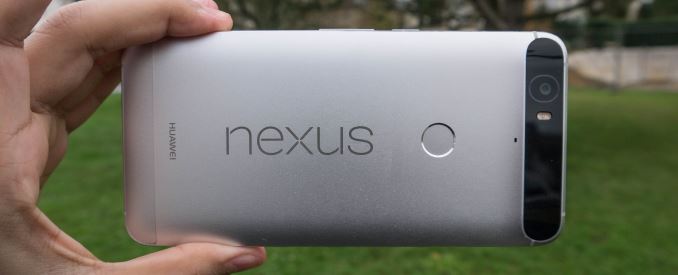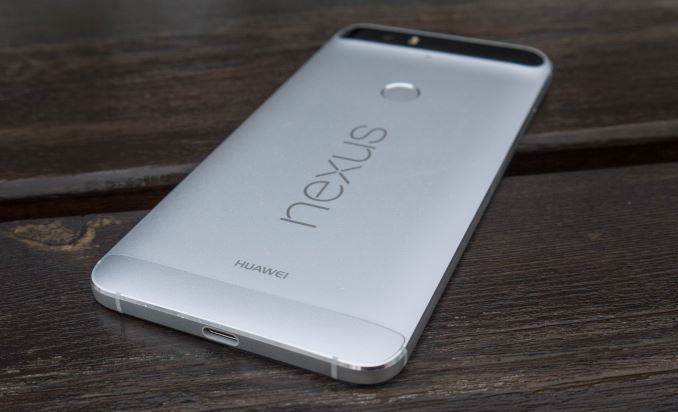The Google Nexus 6P Review
by Andrei Frumusanu on December 16, 2015 8:00 AM ESTFinal Words
As we reach the conclusion of our Nexus 6P review, we’re hopefully left with a more educated view of how the 6P performs and why it perform as it does. It’s also the first showing from Huawei as a Nexus partner, and I think that Huawei has proven itself to be an extremely competent partner at that.
Design-wise, the Nexus 6P takes advantages of Huawei’s experience in building aluminium uni-body phones which results in an extremely solidly built device. While the front face of the phone doesn’t have too much character to it due it being little more than an all-black glass surface with screen and the two speaker grills, it’s the back that makes the Nexus 6P to be instantly recognizable. The “visor” as people have come to call it serves both as an aesthetic feature as well as a practical one as it houses the camera system and flash.
The metal finish and polish makes for a solid grip that is helped by the comparatively flatter sides of the device. Here the 6P trades in a bit of in-hand feel for better handling of the large form-factor. And make no mistake as the Nexus 6P is very much a large form-factor phablet device. The 5.7” screen compares to competing devices such as the Note 5 or the Mi Note Pro, however the 6P is noticeably larger than its cousins due to larger bezels both on the sides and especially on the top and bottom.
The large screen is backed by an excellent AMOLED panel from Samsung. Here Google seems to have made a much better choice in panels than what we saw in last year’s Nexus 6 or what Huawei seems to have employed in their own Mate S. Picture quality is comparable to the Note 5, although the 6P loses out in terms of efficiency, only able to slightly beat the Note 4’s screen efficiency.
Performance wise, the Nexus 6P is excellent. Huawei’s internal design and handling of the SoC’s thermal dissipation makes this the best implementation of Qualcomm’s Snapdragon 810 SoC. CPU performance is currently among one of the best, particularly in bursty workloads, although it can’t really match the sustained and consistent performance of Samsung’s Exynos 7420 devices or even last year’s Snapdragon 801/805 phones. Gaming performs well too, although we again see that sustained performance is only about half of peak performance, an issue competing high-end Android devices also have to deal with.
Battery life, while being subjectively is very good to the point that no user would have to complain about it, it still falls behind the competition. I’ll be honest and say that 2015 has been a pretty bad year for Android devices, as other than Samsung, vendors had to rely on the Snapdragon 810/808’s rather disappointing power efficiency. It’s the fact that you know that a device could have done much better had it had a different SoC that simply leaves me hesitant in praising the Nexus 6P’s battery life. It reminds me of Huawei’s own Mate 7, which while it had excellent battery life due to the very large battery capacity, it failed to be able to provide results worthy able to live up to the specifications.
Meanwhile the camera on the Nexus 6P is among the best, although there were some software processing and consistency issues discovered. Due to these issues encountered in my testing I’m a bit undecided on how to evaluate the 6P’s camera. In situations where it manages to perform, it performs excellently. But as we’ve seen there’s also scenarios where it struggles to get good exposure, and I view that as more important than having an edge in sharpness and effective spacial resolution. And an edge in sharpness is something the Nexus 6P very much has. While the Nexus 6P’s daylight performance can be argued about, it absolutely seems to lead in low-light scenarios as the camera sensor is able to resolve that much more details than the competition; as long as it exposes and color-balances correctly (most of the time).
Wrapping things up, we’re left with the question of the Nexus 6P is a worthwhile buy or not. Here I’d like to offer two conclusions, one for US users and one for buyers in Europe and the rest of the world. At a US price starting at $499 for an unlocked variant, it seems that the Nexus 6P hits a sweet-spot in terms of price-performance and is able to position itself very competitively against other devices. Google’s own services are also much more prevalent and far reaching in North America, so there’s definitely advantage of having a pure Nexus experience (Along with the non-carrier firmware advantage). Here the Nexus 6P is definitely a worthwhile purchase.
For regions outside of North America, and Europe especially, the Nexus 6P just seems an unreasonable device. Starting at prices from 649€, you would expect a device without drawbacks, and it’s simply not worth the premium over other devices, or at the same price you’ll be better off with an equally priced S6 Edge+ or Note 5 if it’s available in your region. Here, the Nexus 6P just simply doesn’t seem that attractive unless you’re putting a lot of weight into the Google Nexus experience, which I find to be a rather subjective aspect of the device. With Snapdragon 820 phones coming in just a few months there’s also the viable option to hold out for better alternatives as we're on the verge of a large generational jump that will undoubtedly bring a lot of improvements to the table.












219 Comments
View All Comments
grayson_carr - Thursday, December 17, 2015 - link
*car, not carerstuart - Thursday, December 17, 2015 - link
Then you have a non-standard compliant USB-C to USB-A cable. A USB-C charging device must indicate the maximum charging rate it supports using a resistor across the CC pins (A5 & B5). The values are 10K for 3A, 22K for 1.5A and 56K for legacy (0.5A). (This can be found in the USB specs, which are free to download from usb.org.)The issue is a passive USB-A to USB-C cable can't know what charging rate the device it connects will support, so the spec only allows on value for such adaptors - 56K, which means legacy (0.5A).
Your cable probably claims to support 3A. If it is connected to a cheap charger that is also non-standards compliant, your at risk of causing a fire.
Right now the USB-C market is a mess. I wanted to verify the USB-C to USB Micro A adaptor I purchased had the right resistor, and since the pins on USB-C are about as wide as a bees dick I purchased a USB-C breakout PCB (like this https://www.saikosystems.com/Web/images/Product/ic... ). It had no resistor at all, so I purchased a different brand. It was the same. I am pretty persistent, so I own 15 of them now. Not one is standards compliant.
grayson_carr - Friday, December 18, 2015 - link
I have the USB-A to USB-C cable from the Google Store... and Benson Leung, the Google employee who has been testing them, says it is spec compliant. Having a compliant cable does not mean you can only charge at 0.5A. It just means you can't charge at 3A like you can with a USB-C to USB-C cable.grayson_carr - Friday, December 18, 2015 - link
Also, your view of how USB cables work is too simplistic and wrong. If a USB-A to USB-C cable has a 56K pull-up resistor (as it should), it doesn't just automatically default to the base rate of 0.5A. It will defer to the USB BC 1.2 protocol to negotiate an appropriate current that both the charger and device can handle.SanX - Wednesday, December 16, 2015 - link
One thing bothered me in previous models inluding Nexus 6 was permanent focus "hoping" during video recording when you turn the camera like all cheapo camcorders do. That was present in all modes, the 1080 or 2160. This defect literally trash all your movies specifically visible and annoying in 2160. Must be a second camera module (they are cheap novadays, just a few dollars) which has to do hoping while the main one just do the final focusing if needed.JMC2000 - Wednesday, December 16, 2015 - link
I find the issue with the orientation of the back button a bit funny; personally, I despise having back on the right side of the navbar, and I'm right-handed. I can't stand the location of the back button on my Note 4, yet using on-screen buttons on it drives me insane.Whenever I run Cyanogen/ASOP roms, I always use this navbar layout (left to right):
Menu, Back, Home, Recents, Search
bogda - Thursday, December 17, 2015 - link
I am really dissaponted with direction Nexus devices took. Back in a days when I bought my Nexus 7 it was a very good device for a money. Now Google is dropping all reasons to buy Android vs iOS device. If I want iOS device I will buy one not, Android device with all annoying features of iOS devices and higher resolution display.And price in Europe that is 40% higher than in US is a cherry on the top.
oRAirwolf - Thursday, December 17, 2015 - link
Would you guys be so kind as to provide us with your testing methodology for determining NAND speeds? I know you have used Androbench in the past, but you mentioned that you used some custom settings. What settings are you using? I'd like to be able to compare the performance of some other of my devices that haven't been benched to get an idea how they compare.Thanks for your great review. I hope to see a Pixel C review soon :)
hfm - Thursday, December 17, 2015 - link
You guys seriously need editorial review. I got hung up on poor grammar and sentence structure a couple times in the review.Larry Endomorph - Thursday, December 17, 2015 - link
Agreed. More than "a couple times". Many more. And spelling errors.